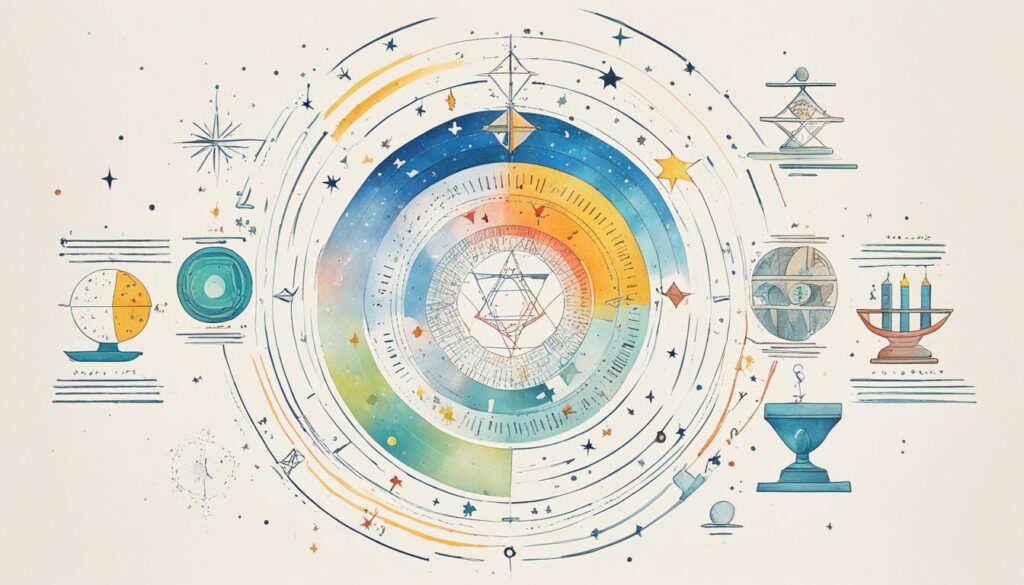If you’re captivated by the night sky, the water jar asterism within the Aquarius constellation is a celestial wonder that shouldn’t be missed. This distinct pattern of stars, also known as the Urn, forms an integral part of the narrative surrounding Aquarius, one of the most storied constellations in the zodiac. Resembling a “Y” shape, this group of stars vividly illustrates the mythological Water Bearer’s jar, an image that has piqued human curiosity for generations.
For those seeking to explore the stars, the Water Jar asterism provides a captivating gateway to deep sky observations. Joining the constellation’s story with celestial navigation allows you to deepen your understanding of the night sky’s structures and their historical influence. As you gaze upon the quartet comprising of Gamma, Pi, Eta, and Zeta Aquarii, you connect to a storied human tradition stretching back into antiquity, illuminated by Wikisky’s images that showcase the sheer beauty and scale of these astronomical formations.
Key Takeaways
- Discover the water jar asterism and its prominent location within the Aquarius constellation.
- Learn about the celestial narrative of the Water Bearer and the Y-shaped configuration of the stars that pour out a cosmic waterfall.
- Understand the individual stars—Gamma, Pi, Eta, and Zeta Aquarii—that compose this intriguing asterism.
- Recognize the relationship between the Water Jar asterism and the constellation Piscis Austrinus, with its bright star Fomalhaut.
- Appreciate the Water Jar’s historical significance, capturing the imagination of cultures around the globe.
- Utilize high-quality images provided by Wikisky to visualize and grasp the structure of this unique celestial pattern.
Unveiling the Water Jar Asterism in the Aquarius Constellation
The Aquarius water jar, a fixture of the night sky, captures the astrological essence and mythology embedded within the stars. As you gaze towards the heavens, you are not merely observing celestial bodies, but also delving into ancient stories etched across the cosmos.
Origin and Mythology Behind the Constellation
In the realm of mythology, the Aquarius constellation is inextricably linked to Ganymede, the beautiful mortal who caught the eye of Zeus. The imagery of the zodiac water jar, cascading an eternal stream of stars, weaves through these ancient tales along with the revelation of Ganymede’s divine ascent. This celestial mapping of myth forever enshrines his figure in our night sky.
Mapping the Stars: Gamma, Pi, Eta, and Zeta Aquarii
While the stars of Aquarius collectively form an elegant pattern, each star of the Water Jar asterism shines with its own story. None of them are physically tethered; they span across light-years, from the closest Zeta Aquarii to the distant Pi Aquarii, which could one day illuminate our skies as a supernova. Their unique characteristics, from luminosity to rotational speed, contribute to the asterism’s overall splendor and scientific intrigue.
The Celestial Connection: Aquarius and Piscis Austrinus
The significance of the water jar constellation unfolds in the expansive narrative connecting Aquarius and Piscis Austrinus. As the mythological waters stream downwards from the celestial jug, they flow toward the open mouth of Piscis Austrinus, represented by the bright Fomalhaut. This elegant coordination of the stars offers a stark reminder of the intricate web spun by galactic relationships within the grand cosmic design.
Stargazing Essentials: Locating the Water Jar in the Night Sky
For those with a passion for star gazing, finding constellations like the Water Jar asterism adds a rewarding challenge to their celestial explorations. Ideal for astronomy enthusiasts and casual stargazers alike, the Water Jar asterism offers a glimpse into the grandeur of the cosmos from the comfort of Earth.
To begin your quest to locate the Water Jar asterism, your journey starts by identifying the notable constellation of Pegasus. Markab serves as your benchmark at the Great Square’s southwest corner. Remember, the larger-than-life figure of the supergiant Enif also stands as a guiding beacon in your cosmic search.
- Look towards Pegasus to guide you in the right direction.
- The Water Jar rests to the south of this constellation, quietly waiting to be discovered.
- Survey the region west of the Water Jar to recognize the stars Sadalsuud and Sadalmelik, both are part of Aquarius.
Another celestial marker to consider is the globular cluster known as Messier 2, residing along a straight line drawn from Zeta Aquarii passing through Sadalsuud. Viewing it may require optical assistance, but its brightness is a stargazer’s delight when captured through a small telescope.
Although Scanning the sky is the essence of star gazing, being well-equipped and knowledgeable about the landmarks that light up the night can make the difference between a pleasant evening and an astronomical triumph. When the stars align, so to speak, you will successfully pinpoint the Water Jar and revel in the natural wonder above our heads.
| Observation Pointers | Details |
|---|---|
| Starting Constellation | Pegasus |
| Key Stars | Markab (southwest corner of Great Square), Enif (supergiant) |
| Adjacent Celestial Features | Aquarius Stars (Sadalsuud, Sadalmelik), Globular Cluster (Messier 2) |
| Optimal Viewing Tools | Small Telescope (for Messier 2) |
| Advice for Novices | Use a star chart or app to track the constellations’ movements and locations. |
Armed with the knowledge of these celestial coordinates and visual references, your endeavor to capture the essence of the Water Jar asterism is bound to be successful. Clear skies and a curious mind are all that stand between you and the beautiful structures that span our night sky.
Water Jar Asterism and Its Role Across Cultures
The water jar constellation, known as the Water Jar asterism, has enchanted skywatchers for ages, serving as a cultural touchstone across various civilizations. Each culture has bequeathed unique interpretations and names to these stars, enriching our celestial nomenclature and understanding of different worldviews tied to the cosmos.

Ancient Interpretations: From Tomb to Tent
In the rich tapestry of the night sky, few formations have been as compelling across time and cultures as the Water Jar asterism. The Chinese sky, with its own celestial nomenclature, referred to it as the Fén Mù, meaning the fascinating Tomb asterism within the extensive Roof mansion area. This depiction conjured a vision of a cosmic place of rest within the stars.
Contrastingly, in Arabic astronomy, these stars were collectively known as al Aḣbiyah, or ‘the Tent,’ where each star was ascribed a role in providing shelter and fortune. These ancient interpretations demonstrate how the night sky served as a canvas onto which our ancestors projected their values and ways of life.
Lucky Stars: Naming and Symbolism in Arabic Astronomy
The tradition of naming stars has revealed much about past cultures. Arabic astronomy, for instance, has contributed significant star names, often with auspicious connotations such as “luck of the homes” and “luck of the tents.” Among the stars of the Water Jar asterism, certain celestial bodies were considered lucky stars, their nomenclature signifying their importance in predicting fate and fortune.
One such star that retains its cultural heritage is Gamma Aquarii, bearing the historical name Sadachbia—which means ‘luck of the homes.’ This assignation reflects not only the star’s role within its constellation but also its perceived influence over the lives of those who gaze upon it.
Celestial Nomenclature: Understanding Star Names
The process of naming stars within celestial nomenclature is layered with the mysteries and complexities of cultural significance. For example, while Sadachbia enjoys the prominence of formal recognition, its fellows in the asterism such as Pi, Eta, and Zeta Aquarii are less individually distinguished by name but equally important within Arabic astronomy and celestial nomenclature.
Understanding these star names and their origins sheds light on the narrative tapestry we have woven around the night sky, revealing how these celestial beacons have guided human interpretation and mythology throughout history.
| Star | Cultural Name | Meaning | Astronomical Name |
|---|---|---|---|
| Gamma Aquarii | Sadachbia | Luck of the homes | γ Aquarii |
| Pi Aquarii | — | — | π Aquarii |
| Eta Aquarii | — | — | η Aquarii |
| Zeta Aquarii | — | — | ζ Aquarii |
The Cosmic Quartet: Profiling the Stars of the Water Jar Asterism
Profiling the Water Jar stars introduces you to the cosmic quartet, each an astronomical marvel with unique characteristics shaping the mythology and observations of the night sky. Let’s illuminate these celestial players in the great aquatic narrative of Aquarius.
Zeta Aquarii, often the most brilliant of the quartet, is not a lone star but a triple star system. It is relatively close, considering the vastness of the universe, at just over 90 light-years away. Known for its stability and mature glow, Zeta is often outshone in the youth department by its companions, Eta and Gamma Aquarii.
Pi Aquarii tells a more tempestuous tale. Lying roughly 780 light-years from Earth, it brims with the volatile potential of a future supernova. This star’s immense mass suggests an explosive destiny that underscores the dramatic lifecycle of stars.
Eta and Gamma Aquarii flaunt their juvenile flair. Though younger, they compete with Zeta, spinning at high velocities and burning brightly. Within the cosmic quartet, they are the vibrant youngsters, casting their energetic light across space.
As we profile these Water Jar stars, their unique attributes emerge – they are not just points of light but a symphony of cosmic narratives, each playing its tune in the grand orchestration of the universe.

| Star Name | Distance from Earth (light-years) | System Type | Characteristics |
|---|---|---|---|
| Zeta Aquarii | Approx. 92 | Triple Star System | Mature glow, enduring brightness |
| Pi Aquarii | Approx. 780 | Single Star | Potential supernova candidate |
| Eta Aquarii | Varies | Single Star | High spin velocity, younger spectrum |
| Gamma Aquarii | Varies | Single Star | High luminosity, youthful |
By profiling these Water Jar stars, you grasp an intimate understanding of the cosmic quartet, whose dance through time and space has captured human fascination for millennia. As observers and admirers, we continue to uncover the wonders and narrative of the Water Jar asterism, one star at a time.
Navigating the Celestial Waters: How to Best Observe the Water Jar
As an enthusiast eager to delve into the mysteries of the night sky, you’re invited to explore one of the night sky’s lesser-known wonders, the Water Jar asterism within the Aquarius constellation. With the right timing and tools, you can transform your stargazing into an astronomical adventure. The key is knowing precisely when and how to observe this stellar formation.
When to Watch: Timing Your Observation
The best time to see the Water Jar asterism is during the clear, autumn evenings when the Aquarius constellation rises majestically in the night sky. To improve your chances of a splendid view, aim for the times when the moon is new or in its waning phase to avoid the interference of moonlight with the delicate twinkling of this celestial spectacle.
Utilizing the Great Square of Pegasus as a Guide
Navigating the sky can be daunting, but the Great Square of Pegasus offers an easily recognizable signpost. By looking southward from this famous square, you can locate the Water Jar hanging in the watery expanse of Aquarius. The stars of the Great Square serve as your guiding beacon towards the quieter radiance of this asterism, enhancing your stargazing guide experience.
The Best Equipment for a Stellar Experience
Embarking on this celestial journey warrants the use of proper astronomical equipment. While the naked eye can appreciate the Water Jar’s location, binoculars will provide the initial dazzle of its stars. For deeper exploration and a front-row seat to the cosmos’s hidden details, consider utilizing a telescope, which can bring into focus not only the asterism but also the surrounding deep-sky objects, like the brilliant globular cluster M2. Be sure to prepare for varying magnifications and conditions—stargazing tools like star maps and apps can further enhance your viewing experience.
Remember, each stargazing moment is unique to its time and place in the universe. Take your time, be patient, and the Water Jar asterism, along with its celestial neighbors, will unveil themselves to you, one stellar twinkling at a time.
Aquarius Constellation: Beyond the Water Jar Asterism
Embark on a stellar voyage beyond the simple beauty of the Water Jar asterism into the expansive realm of Aquarius—a constellation boasting a wealth of deep-sky phenomena. This celestial domain is a storied tapestry that extends far past its famed asterism, containing secrets and cosmic spectacles that await your discovery. With the Aquarius constellation, your stargazing adventure is enriched by the depth and splendor of its astral components.
Exploring Deep-Sky Objects within Aquarius
Astronomy enthusiasts have the opportunity to chase after the many Messier objects nestled within Aquarius. Notably, the enchanting globular clusters M2 and M72 offer captivating sights. These deep-sky treasures are not only a treat for the eyes but also a gentle reminder of the sheer scale and mystery of our universe. As you position yourself in relation to the Alpha and Beta stars of Aquarius, these deep-sky jewels reveal themselves, making Aquarius a constellation replete with deep-sky marvels.
Aquarius and Its Place in the Zodiac
Your astrological musings are incomplete without considering the zodiac water jar—that is, the influential position Aquarius holds within the zodiac. Teeming with historical and astrological significance, Aquarius intersects with the paths of the Sun, Moon, and wanderers of our solar system at various times, echoing the ancient connection we’ve always had to the stars. The water that Aquarius pours forth resonates with various cultural interpretations, some seeing it as a symbol of good fortune, others as a signifier of impending renewal.
Historical and Astrological Significance of the Water Bearer
The astrological water jar is just one aspect of Aquarius’s rich narrative. The constellation’s lead character, the Water Bearer, is entrenched in tales that have traversed time and civilizations. Embodying the affluence of water, the Water Bearer in historical accounts—from Greek mythology to Egyptian influence—has been linked to life-giving forces and divine providence. Sadalmelik and Sadalsuud, the brightest stars in Aquarius, serve as beacons in the night sky, guiding your gaze to a constellation that has been a pivotal part of the human story, its historical significance glaring as vibrantly as its stars.
FAQ
What stars make up the Water Jar asterism?
The Water Jar asterism within the Aquarius constellation is formed by four stars: Gamma, Pi, Eta, and Zeta Aquarii. These stars outline the celestial water jar from which water appears to flow.
Can you explain the mythology behind the Aquarius constellation?
The Aquarius constellation is often associated with the Greek myth of Ganymede, a handsome young man and son of King Tros. Ganymede was brought to Olympus by Zeus to serve as the cupbearer to the gods and later placed among the stars as the constellation Aquarius, the Water Bearer.
How is the Water Jar connected to the Piscis Austrinus constellation?
The Water Jar asterism is symbolically linked to the Piscis Austrinus constellation. The stream of water poured by the Water Jar flows toward the Southern Fish’s mouth, marked by the bright star Fomalhaut in Piscis Austrinus.
When is the best time to see the Water Jar asterism?
The Water Jar asterism is best observed during the autumn months in the Northern Hemisphere when the Aquarius constellation is high in the evening sky.
What are the cultural interpretations of the Water Jar asterism in history?
Different cultures have interpreted the Water Jar asterism in various ways. In Chinese astronomy, it was seen as part of the Roof mansion, whereas in Arabic astronomy, it was known as al Aḣbiyah, or “the Tent,” with the stars believed to influence one’s fortune.
How did the stars in the Water Jar asterism get their names?
The stars within the Water Jar asterism in Arabic astronomy were given names that referred to luck and homeliness, such as “luck of the homes” and “luck of the tents.” However, among these, only Gamma Aquarii has a widely recognized formal name, Sadachbia, reflecting its Arabic astronomical heritage.
What kind of astronomical equipment is best for observing the Water Jar asterism?
To observe the Water Jar asterism, binoculars can be used to appreciate the bright globular cluster M2, while a small telescope can provide a clearer view of the asterism’s details and nearby celestial bodies.
Are there any other notable deep-sky objects within the Aquarius constellation?
Yes, the Aquarius constellation is home to several deep-sky objects, including the globular clusters Messier 2 (M2) and Messier 72 (M72), which can be located in relation to the constellation’s brightest stars.
What is the astrological significance of the Aquarius constellation?
In astrology, the Aquarius constellation represents the Water Bearer and is a symbol of water, often associated with fortune or cleansing deluges. It is one of the zodiac constellations through which the Sun, Moon, and planets appear to travel.
How can I use the Great Square of Pegasus to locate the Water Jar asterism?
The Great Square of Pegasus serves as a reference point for locating the Water Jar asterism. By finding the square’s southwest corner marked by the star Markab, you can look south to find the Water Jar situated between the stars Sadalsuud and Sadalmelik of the Aquarius constellation.






